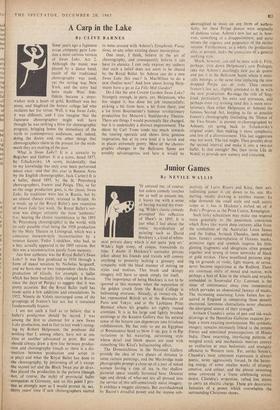A Carp in the Lake
By CLIVE BARNES
What is Swan Lake? It is a scenario by Begichev and Geltser. It is a score, dated 1877, by Tchaikovsky. (A score, incidentally, that to my knowledge has only ever been performed uncut once--and that this year in Buenos Aires by the English choreographer, Jack Carter.) It is a ballet, dated 1895, by the St. Petersburg choreographers, Ivanov and Petipa. This, so far as the stage production goes, is the classic Swan Lake. Its traditions were lost in Russia, but by an almost chance event, retained in Britain. As a result, up to the Royal Ballet's new recension of Swan Lake last week, the Royal Ballet's ver- sion was almost certainly the most `authentic' (i.e., bearing the closest resemblance to the 1895 St. Petersburg choreography) in the world, with its only possible rival being the 1958 production by the Maly Theatre in Leningrad, which was a conscious museum-style reconstruction by a veteran dancer, Fedor Lopukhov, who had, as a boy, actually appeared in the 1895 version. But this was a reconstruction purely from memory.
Just how authentic was the Royal Ballet's Swan Lake? It was first produced in 1934 through a form of dance notation by Nicholas Sergueeff, and we have one or two independent checks (his production of Giselle, for example, a ballet which has been basically little changed in Russia since the days of Petipa) to suggest that it was pretty accurate. But the Royal Ballet itself has made quite a few additions and emendations. In 1952, Ninette de Valois rearranged some of the groupings of lvanov's last act, but it remained fundamentally lvanov.
I am not such a fool as to believe that a ballet's production should be sacred. I was among the first to clamour for a new Swan Lake production, and in fact in last week's restag- ing by Robert Helpmann, the producer did nothing that I, among others, have not at one time or another advocated in print. But one should always draw a firm line between produc- tion and choreography (much as there is a dis- tinction between production and script in a play) and what the Royal Ballet has done to the choreography, by jettisoning all of it except the second act and the Black Swan pas de deux, has placed the production in the pattern (though not, of course, the style) of provincial ballet companies in Germany, and on this point I pro- test as strongly now as I would protest in, say, thirty years' time if new choreographers started to mess around with Ashton's Symphonic Varia- tions, or any other existing dance masterpiece.
One must, I think, believe in the art of choreography, and consequently believe it can have its classics. I can only express my sadness that such a belief does not seem to be shared by the Royal Ballet. So Ashton can do a new Swan Lake this year? Is MacMillan to do a new Ondine next? And how about letting Help- mann have a' go at La Fille Mal Gatylee?
Do I like the new Covent Garden Swan Lake? Strangely enough, in parts, yes. Helpmann, who has staged it, has done his job resourcefully, picking a bit from here, a bit from there, and a lot from Bourmeister's famous revolutionary production for Moscow's Stanislaysky Theatre. There are things I would personally like changed, but it is undeniably a distinct improvement. The decor by Carl Toms tends too much towards the touring operatic and shows little genuine inspiration, but at its own level it is lavish and in places extremely pretty. Most of the choreo- graphic changes in the Ballroom Scene are notably advantageous, and here it would be shortsighted to insist on any form of authen- ticity, for these Petipa dances were originally of dubious value. Ashton's new last act is, how- ' ever, something of a disappointment, and quite misses the urgency and poignancy of the earlier version. Furthermore, as a .whole the production also, at present, lacks the conviction of a general unifying style.
Much, however, can still be done with it. First, perhaps, trim down Helpmann's new Prologue, take out Ashton's dazzlingly new pas de quatre and put it in the Ballroom Scene where it musi- cally belongs, at the same time replacing the now dropped Petipa pus de trois. Then restore lvanov's last act, slightly amended to fit in with the new production. Re-stage the role of Sieg- fried, particularly his exits and entrances, and perhaps even try revising (and this is more revo- lutionary than either Helpmann or Ashton) the famous Second Act, keeping as far as possible Ivanov's choreography (including the 'Dance of the Two Swans.' at present re-choreographed by Ashton), yet going back to Tchaikovsky's original order, thus making it more symphonic and less of a divertissement. This last suggestion may not work. The rest might. Then possibly drop the second interval and make it into a two-act ballet. Is that enough? No, then invite Lila de Nobili to provide new scenery and costumes.






























 Previous page
Previous page